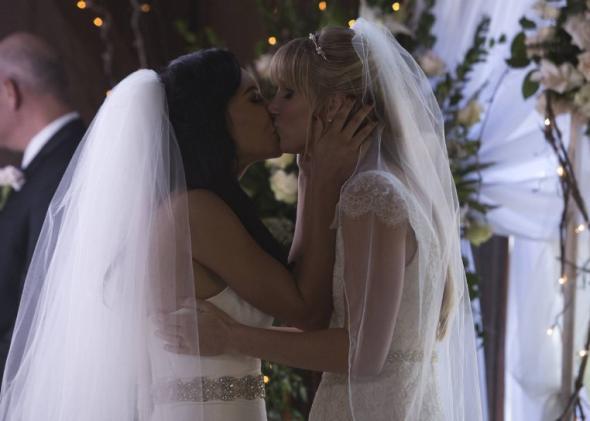I have a totally untestable theory that Glee did more to normalize homosexuality than any other show in TV history, perhaps more than any other mainstream work of art. Over six seasons, tweens, teens, and their families sat in living rooms around the world watching musical numbers, show choir competitions, and hormonal high-school drama stacked with more than its fair share of comings out, same-sex crushes, and gender noncomformity.
But the final season, which comes to an end Friday night with a two-hour episode, is the gayest thing I’ve ever seen on television—and ever expect to see. The TV version of Lima, Ohio, is a fantasy world where sexual minorities rule the roost and heterosexuals are background players, coming into focus only when they interact with queer characters.
Just one opposite-sex couple took up significant screen time this season: Becky Jackson and Darrell, the hot barista boyfriend Sue’s former sidekick brought home from college. But Becky and Darrell’s relationship was mostly an excuse for the rest of the cast to freak out about the ethics of a romantic relationship between a woman with Down Syndrome (Becky was one of four Glee characters with the condition) and an able-bodied guy. Then again, if there’s an area where creator Ryan Murphy is more of an outlier than with the presentation of queer youth, it’s in his commitment to putting people with disabilities at the center of his shows.
The sole mixed-sex kisses so far this season have been between Rachel Berry and Sam Evans, but they only came about because Sue Sylvester had hypnotized Sam as part of a bizarre Manchurian Candidate meets Chucky conspiracy to reunite Kurt Hummel and Blaine Anderson. Of course, the final clauses of that last sentence point to the biggest problem with treating the world of Glee as a model post-homophobic society: It often makes no sense. Ryan Murphy has always had problems following the rules of narrative logic, but in this final season, he seems to have given up on trying. This made for some spectacularly awful episodes—it wouldn’t surprise me to learn that Episodes 4 and 5, a two-parter in which Sue Sylvester wielded a level of power that would make Kim Jong-un blush—were an attempt to repel all but the most devoted Gleeks.
But unlike Sue, who resorted to subterfuge in order to achieve her goal of bringing Kurt and Blaine back together, the writers stated the show’s pro-gay agenda quite explicitly: In Episode 6, when Brittany S. Pierce still hopes that Santana Lopez’s grandmother will get over her homophobia and attend their wedding, she tells her fiancee:
Maybe it’s our job as young, hot progressives to educate older, scary farts. If Abuela gets to know us and sees that we’re somewhat normal … then she’ll see us for who we really are. And then maybe she’ll understand that aside from the awesome lesbian sex part, we’re just like everybody else.
Glee also shows that all this modeling of good LGBTQ behavior pays off. Spencer Porter, a football-playing “postmodern gay” new to the show this season, explains to Rachel that “positive representations of gays in the mass media have given me the confidence I need to be myself, which, it turns out, is kind of an arrogant jerk.” Kurt goes on a date with Walter, a fiftysomething guy who is fresh out of the closet and tells Kurt he regrets “the lifetime of love” he could have enjoyed if he hadn’t wasted it “pretending to be someone I’m not.” Even Coach Beiste, who came out as trans this season, became a gay man.
Coach Beiste’s transition also highlighted another Glee weakness—its inconsistency. Even in absolute dictator mode, Sue was completely supportive of the coach’s transition, had learned about concepts like cisnormativity and transmisogyny while Beiste was away getting top surgery, and stood up to transphobic attacks against him—and then she turned around and bullied members of another vulnerable group. “McKinley High is now a fully gender-fluid high school,” she declared. “Now if you’ll excuse me, out of the corner of my eye, I see a fatty who could use a good, healthy fat-shaming.”
Glee was rarely an explicitly political show—though there were a few sloganeering moments, as when Burt Hummell delivered this sick burn to Ohio: At the double wedding of Brittney and Santana and Kurt and Blaine in Indiana, a marriage equality state, he told the congregation that didn’t know how lucky he had been in marriage “until I had to drive over the state line to come here to officiate the wedding of these two loving couples.”
Glee was all about teaching young people to be themselves, no matter how people responded to their truth. When Santana’s abuela refused to attend their wedding, Brittney let her have it: “I’m glad you’re not coming,” she told her. “The New York Times says half the increase in support for gay marriage is due to generational turnover. That’s what smart people call, ‘crazy uptight bitches dying.’ ” Who will educate those older, scary farts when Glee takes its final bow?
Correction, March 19, 2015: This post originally misspelled Burt Hummel and Coach Beiste’s names.
